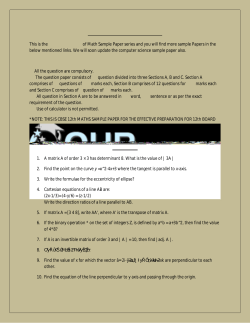
Document 284985
Technology offer: Fast and reliable calibration method for sample analysis Technology offer: Device for fast calibration by analytical techniques SUMMARY During the last couple of years, the Group of Applied Analytical Chemistry of the Department of Analytical Chemistry of the University of Alicante has developed several methods and strategies for the analysis of samples of different nature. TECHNICAL DESCRIPTION Most of the analytical techniques are comparative. Therefore, sample analysis should be carried out through calibration. A given number of standards must be analyzed in the same way as the sample, the analyte concentration in the sample being determined by means of an interpolation procedure. This is a rather time consuming step. To the analyzer Tubbing 1 Solution 1 Peristaltic pump 2 Peristaltic pump 1 Magnetic stirrer Solution 2 (Stirred tank) Figure 1 Figure 1 shows a scheme of the setup of the new device for calibration. The main components of the system are: a vessel working as stirred tank, two peristaltic pumps and a magnetic stirrer. The mode of operation is very simple; initially, a given volume of either deionized water or a sample solution is placed inside the tank. At a SGITT-OTRI (University of Alicante) Phone.: +34965903467 Fax: +34965903803 E-mail: otri@ua.es 2 given time, the two peristaltic pumps were switched on so as peristaltic pump 1 (Figure 1) aspires solution 1 and leads it to the stirred tank (solution 2) whereas peristaltic pump 2 drives the solution from the stirred tank towards the analyzer. A magnetic bar is continuously operated in order to homogeneize quickly the solutions inside the tank. A 0.5 mm inner diameter 90 cm length PTFE tubing is used to lead the solution from the tank to the analyzer. To carry out external calibration, the solution initially contained in the tank is deionized water, whereas solution 1 corresponds to a solution with a known analyte concentration. Therefore the standards used for the calibration procedure are automatically prepared and driven to the analyzer without any analyst intervention. The evolution of the analyte concentration of the solution leaving the tank with time was easily derived from: Qe ⎡ ⎤ Q s −Qe ⎞ ⎛ ( ) − + Q Q t V ⎥ s 0 ⎟⎟ C = C s ⎢1 − ⎜⎜ e ⎢ ⎝ ⎥ V0 ⎠ ⎢⎣ ⎦⎥ (1) where C is the analyte concentration inside the stirred tank, Cs is the analyte concentration in solution 1 (Figure 1), Qe is the liquid flow rate at which solution 1 is introduced in the tank (inlet flow), Qs the liquid flow rate at which the solution leaves the tank (exit flow), t the time and V0 the initial volume of the solution inside the tank. The way in which the system is used to obtain the calibration line is as follows: the manifold in Figure 1 is switched on so as the analyte concentration in the solution leaving the tank increases steeply with time. A recording of the analytical signal variation with time is obtained. Once the data are acquired, the time axis is transformed in concentration by means of equation 1 and the emission signal is plotted against the analyte concentration. INNOVATIVE ASPECTS OF THE TECHNOLOGY • • • • • The calibration is rapidily and automatically carried out. Calibration lines with more than 40 standards are obtained in a short period of time (5-10 min). Only a solution has to be prepared. Interferences caused by the sample matrix can be easily eliminated by applying techniques such as standard additions. The same system can be applied to linear and non linar calibration, what is very important for some molecular techniques. So far this method has provided good results for biological and environmental samples and foods. SGITT-OTRI (University of Alicante) Phone.: +34965903467 Fax: +34965903803 E-mail: otri@ua.es 3 CURRENT STATE OF THE TECHNOLOGY The system developed has been applied in our laboratory for the elemental analysis by Flame atomic absorption spectrometry (FAAS) Inductively Coupled Plasma Atomic Emission Spectrometry (ICP-AES) Inductively Coupled Plasma Mass Spectrometry (ICP-MS). However, it can be easily adapted for its use in Molecular UV-VIS and IR absorption spectroscopy. Compared with conventional calibration methods this accesory affords: • • • • Better precisions. Shorter analysis times. Reduced analysis costs. Simplicity. INTELLECTUAL PROPERTY RIGHTS All the information is protected by know – how. MARKET APPLICATIONS The method described can be used by any laboratory analyzing liquid samples. COOPERATION SOUGHT Currently we have the technology required to developing and implantation of the method in an analysis laboratory. RESEARCH TEAM PROFILE This group was created in 2003. Nowadays, the group consists of one Professor, one assistant professor and several pre-doctoral students. We have experience on the following research subjects: • • • • Development of new liquid sample introduction systems for plasma spectroscopy. Development of new fast calibration methods for comparative (relative) analytical techniques. New strategies for the dissolution of solid samples. Methods for the digestion and analysis of plastic materials. SGITT-OTRI (University of Alicante) Phone.: +34965903467 Fax: +34965903803 E-mail: otri@ua.es 4 • • • • • • • Development of methods for the determination of the Chemical Oxygen Demand in wastewaters. Metal speciation. Hydrocarbon and organic acids determination through HPLC - ICP-AES. Food analysis. Steel analysis. Seawater analysis. Clay analysis. CONTACT DETAILS Víctor Manuel Pérez Lozano SGITT-OTRI (University of Alicante) Phone: +34 96 590 9605 Fax: +34 96 590 3803 E-Mail: otri@ua.es URL: http://sgitt-otri.ua.es/es/empresa/ofertas-tecnologicas.html SGITT-OTRI (University of Alicante) Phone.: +34965903467 Fax: +34965903803 E-mail: otri@ua.es 5
© Copyright 2025





















